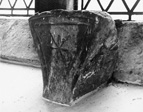Select a site alphabetically from the choices shown in the box below. Alternatively, browse sculptural examples using the Forward/Back buttons.
Chapters for this volume, along with copies of original in-text images, are available here.
Object type: Cross-arm
Measurements: H. 22.5 cm (9 in); W. 29 > 22.5 cm (11.5 > 9 in); D. 9.5 cm (3.75 in)
Stone type: Red sandstone (Permo-Triassic sandstone)
Plate numbers in printed volume: 422 - 4
Corpus volume reference: Vol 2 p. 125
(There may be more views or larger images available for this item. Click on the thumbnail image to view.)
A (broad): The arm, type E10, is outlined by a neat double-grooved moulding, and in the centre at the top is a complex, deeply incised St Andrew's cross cutting a Latin (A1) type cross which has shorter arms. A faint circle encloses the St Andrew's cross.
B (narrow): Plain with some hint of a projection at the top.
C (broad): Broken at the top, smooth and plain at the base.
D (narrow): Plain.
This head could well belong to that group of pre-Conquest crosses noted in Durham and Northumberland which are only carved on one face (see for example Hexham 8 (Cramp, 1984, pl. 172, 910–13) and Jarrow 9 (Cramp 1984, pl. 93, 497)). The cross is more complex than the one piece in Cumbria, Brigham 6, with which it has been compared (Calverley 1899a, 226). The longer vertical line could indicate that this is to be seen as a form of monogram of Christ's name (see Brown 1921, 90–4). The shape of the arm, outlined by a double moulding, is not unlike High Hoyland or Kirkburton in Yorkshire (Collingwood 1927a, figs. 99, f; 125, l).



